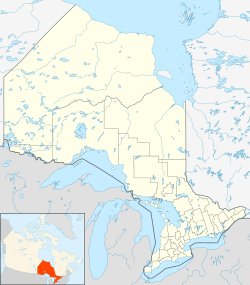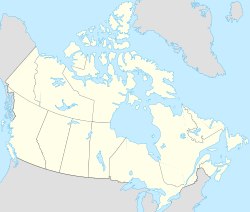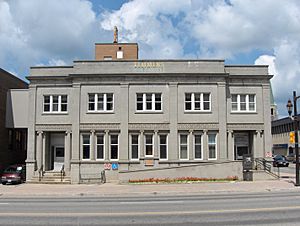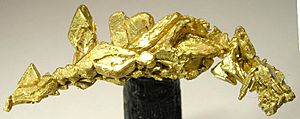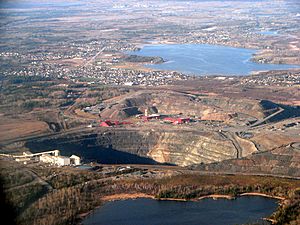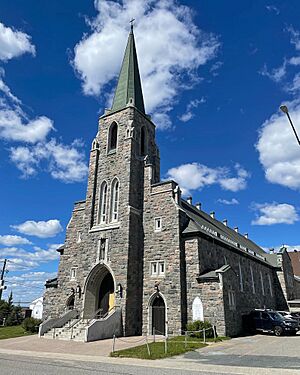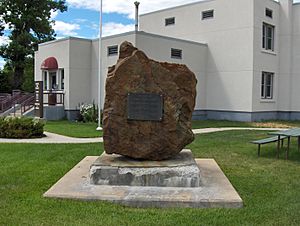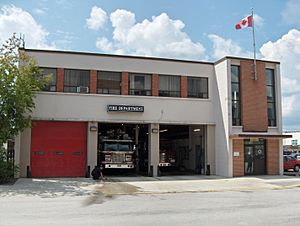Timmins facts for kids
Quick facts for kids
Timmins
|
|||
|---|---|---|---|
| City of Timmins | |||
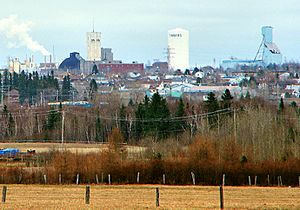
View of Timmins
|
|||
|
|||
| Motto(s):
The City with a Heart of Gold
|
|||
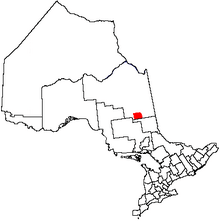 |
|||
| Country | Canada | ||
| Province | Ontario | ||
| District | Cochrane | ||
| Established | 1912 | ||
| Named for | Henry Timmins and Noah Timmins | ||
| Area
(2021)
|
|||
| • Land | 2,955.33 km2 (1,141.06 sq mi) | ||
| • Population centre | 18.49 km2 (7.14 sq mi) | ||
| Elevation | 294.70 m (966.86 ft) | ||
| Population
(2021)
|
|||
| • Total | 41,145 | ||
| • Estimate
(2023)
|
44,967 | ||
| • Density | 13.9/km2 (36/sq mi) | ||
| • Population centre | 28,874 | ||
| • Population centre density | 1,561.3/km2 (4,044/sq mi) | ||
| Time zone | UTC−05:00 (EST) | ||
| • Summer (DST) | UTC−04:00 (EDT) | ||
| Forward sortation area |
P4N to P4R
|
||
| Area codes | 705 and 249 | ||
Timmins is a city in northeastern Ontario, Canada. It is located on the Mattagami River. Timmins is the fourth-largest city in the Northeastern Ontario area. In 2021, about 41,145 people lived there. The city's economy relies on getting natural resources from the earth. This includes industries like lumber and mining for gold, zinc, copper, nickel, and silver. Timmins also acts as a main service and distribution center for the region.
Many people in Timmins speak French. More than half of the residents can speak both French and English.
Contents
History of Timmins
Early Settlements
People have lived in the Timmins area for at least 6,500 years. The first people were nomadic groups of the Shield Archaic culture. When Europeans arrived, the Cree and Ojibwe peoples mainly lived there.
French explorers first met the local Indigenous peoples in the late 1600s. The first attempt to build a lasting European settlement was in 1785. Philip Turnor of the Hudson's Bay Company set up a trading outpost at Fredrick House Lake. This was about 30 kilometers northeast of where downtown Timmins is now.
This trading post was not very successful. It was hard to get supplies, and there was competition nearby. In 1812, the post was abandoned after an attack. It was officially closed in 1821.
Much later, in 1906, Treaty 9 was signed. This treaty involved Indigenous communities and the Canadian government. The Mattagami First Nation agreed to move to the north of Mattagami Lake and give up some land.
The Porcupine Gold Rush
People in the area had known about gold for a long time. But it was hard to reach the region, so there wasn't much interest in mining it.
In 1907, the Temiskaming and Northern Ontario Railway was extended to Cochrane. This made it easier for prospectors (people looking for gold) to get to the area. This led to the Porcupine Gold Rush.
In 1909, two prospectors, Benny Hollinger and Alex Gillies, found a large vein of gold. They found it near some old test pits left by another team. They pulled back some moss and saw a huge amount of gold.
Two brothers, Noah Timmins and Henry Timmins, came to the area in 1910. They started buying parts of local mines. They bought Benny Hollinger's share. Later that year, the Hollinger Mines company was officially started.
The "Moss Slip" Story
There's a popular story about how Timmins was founded. It says a man named Harry Preston slipped on moss and found gold, starting the gold rush. However, historical records tell a different story.
Harry Preston was part of a team that found a large "dome shaped quartz outcrop" in June 1909. The team leader, Jack Wilson, was the first to see gold when the sun hit the quartz.
The story about pulling back moss and finding gold actually comes from Benny Hollinger and Alex Gillies. They found their gold two months after Wilson's team.
Historians agree that the railway expansion was key to starting the Porcupine Gold Rush. It made the area much easier to reach.
Towns and Growth
A town was built near modern-day Gillies Lake for workers of the Hollinger Mines. The mine manager, Alphonse "Al" Paré, named it "Timmins" after his uncle, Noah Timmins. Other mining companies also started their own settlements nearby. These were "Porcupine/Dome" and "Schumacher."
As more workers arrived, these camps grew together to form one town.
The Great Porcupine Fire
On July 10, 1911, very hot and dry weather caused small fires near the Porcupine settlement. Strong winds spread these fires into the dry forest. They grew into a huge wall of fire, about 20 miles wide.
The fire destroyed the Porcupine mining camp on July 11. It continued north to Cochrane. Many people died, some by drowning in the lake while trying to escape. Others were trapped in the mines.
Even with the damage, mine leaders quickly planned to rebuild. The camp was rebuilt fast with help from other communities. The fire also burned away thin layers of soil, revealing new gold veins. This helped the area recover.
Becoming a City and World Wars
After the fire, Noah Timmins planned a new townsite at the Timmins camp. Land was sold starting in September 1911. Many people moved there, and the Timmins camp quickly became bigger than the others. Timmins officially became a municipality (a town with its own local government) on January 1, 1912.
In 1912, miners went on strike for better pay and working conditions. After months, they won a nine-hour workday and a pay raise.
During the First World War, about 600 men from Timmins joined the army. Miners were especially wanted for their skills in digging and handling explosives. The town celebrated greatly when the war ended.
The Great Depression (a time of economic hardship in the 1930s) did not hurt Timmins much. Jobs were still available in mining and lumber.
In the Second World War, about a third of the city's population joined the armed forces. Timmins even had its own bomber squadron. The city's economy was affected because women were not allowed to work in mines at that time.
Recent History
By the mid-1960s, most of the original gold mines had run out of gold and began to close. Hollinger Mine closed in 1968. McIntyre Mines closed in 1988.
In 1973, 35 smaller areas, including Porcupine, South Porcupine, and Schumacher, joined together to form the larger City of Timmins.
The city's population was highest in the mid-1990s. Since then, it has slowly decreased. The last of the original three mines, the Dome Mine, closed in 2017 after 107 years.
Timmins Climate
Timmins has a humid continental climate. This means it has cold, snowy winters. Temperatures in late summer and autumn are often cool. In late spring and summer, it can get quite warm, sometimes with high humidity. The hottest temperature ever recorded was 39.4°C (102.9°F) in 1936. The coldest was -45.6°C (-50.1°F) in 1962.
| Climate data for Timmins (Timmins Victor M. Power Airport) WMO ID: 71739; coordinates 48°34′11″N 81°22′36″W / 48.56972°N 81.37667°W; elevation: 294.7 m (967 ft); 1991–2020 |
|||||||||||||
|---|---|---|---|---|---|---|---|---|---|---|---|---|---|
| Month | Jan | Feb | Mar | Apr | May | Jun | Jul | Aug | Sep | Oct | Nov | Dec | Year |
| Record high humidex | 7.7 | 10.7 | 29.4 | 32.1 | 41.1 | 43.0 | 42.4 | 42.0 | 40.1 | 30.7 | 25.1 | 11.8 | 43.0 |
| Record high °C (°F) | 8.0 (46.4) |
12.2 (54.0) |
27.9 (82.2) |
29.9 (85.8) |
35.3 (95.5) |
38.8 (101.8) |
39.4 (102.9) |
36.7 (98.1) |
36.1 (97.0) |
28.9 (84.0) |
22.0 (71.6) |
14.2 (57.6) |
39.4 (102.9) |
| Mean daily maximum °C (°F) | −10.4 (13.3) |
−7.6 (18.3) |
−0.7 (30.7) |
7.2 (45.0) |
16.8 (62.2) |
22.4 (72.3) |
24.4 (75.9) |
22.8 (73.0) |
17.8 (64.0) |
9.1 (48.4) |
0.8 (33.4) |
−6.5 (20.3) |
8.0 (46.4) |
| Daily mean °C (°F) | −16.4 (2.5) |
−14.4 (6.1) |
−7.5 (18.5) |
0.9 (33.6) |
9.7 (49.5) |
15.3 (59.5) |
17.7 (63.9) |
16.2 (61.2) |
11.7 (53.1) |
4.5 (40.1) |
−3.2 (26.2) |
−11.2 (11.8) |
1.9 (35.4) |
| Mean daily minimum °C (°F) | −22.3 (−8.1) |
−21 (−6) |
−14.4 (6.1) |
−5.3 (22.5) |
2.5 (36.5) |
8.1 (46.6) |
10.9 (51.6) |
9.6 (49.3) |
5.5 (41.9) |
−0.1 (31.8) |
−7.1 (19.2) |
−15.9 (3.4) |
−4.1 (24.6) |
| Record low °C (°F) | −44.2 (−47.6) |
−45.6 (−50.1) |
−37.8 (−36.0) |
−29.4 (−20.9) |
−13.9 (7.0) |
−5.6 (21.9) |
−0.5 (31.1) |
−3.3 (26.1) |
−6.4 (20.5) |
−19 (−2) |
−33.9 (−29.0) |
−43.9 (−47.0) |
−45.6 (−50.1) |
| Record low wind chill | −54.2 | −53.7 | −45.8 | −37.1 | −18.8 | −8.5 | 0.0 | −4.0 | −9.3 | −20.4 | −38.0 | −53.1 | −54.2 |
| Average precipitation mm (inches) | 49.0 (1.93) |
39.9 (1.57) |
48.3 (1.90) |
61.7 (2.43) |
69.9 (2.75) |
80.4 (3.17) |
78.7 (3.10) |
75.6 (2.98) |
81.2 (3.20) |
86.2 (3.39) |
68.9 (2.71) |
56.6 (2.23) |
796.2 (31.35) |
| Average rainfall mm (inches) | 4.0 (0.16) |
1.1 (0.04) |
14.3 (0.56) |
35.3 (1.39) |
63.5 (2.50) |
77.9 (3.07) |
84.8 (3.34) |
77.0 (3.03) |
81.7 (3.22) |
66.8 (2.63) |
28.1 (1.11) |
8.7 (0.34) |
543.1 (21.38) |
| Average snowfall cm (inches) | 59.2 (23.3) |
47.9 (18.9) |
43.2 (17.0) |
25.3 (10.0) |
3.1 (1.2) |
0.2 (0.1) |
0.0 (0.0) |
0.0 (0.0) |
0.5 (0.2) |
13.7 (5.4) |
50.8 (20.0) |
63.8 (25.1) |
307.6 (121.1) |
| Average precipitation days (≥ 0.2 mm) | 18.6 | 15.4 | 14.8 | 12.3 | 13.0 | 15.0 | 14.8 | 14.0 | 15.3 | 17.1 | 19.1 | 19.9 | 189.3 |
| Average rainy days (≥ 0.2 mm) | 1.6 | 0.89 | 3.7 | 7.1 | 12.1 | 14.6 | 14.7 | 14.3 | 14.9 | 14.1 | 6.5 | 2.9 | 107.4 |
| Average snowy days (≥ 0.2 cm) | 18.1 | 14.0 | 11.6 | 6.1 | 1.7 | 0.11 | 0.0 | 0.0 | 0.42 | 5.6 | 15.6 | 18.6 | 91.8 |
| Average relative humidity (%) (at 1500 LST) | 70.4 | 61.7 | 52.9 | 48.9 | 45.7 | 48.8 | 53.1 | 55.5 | 60.4 | 67.1 | 75.1 | 76.9 | 59.7 |
| Source: Environment and Climate Change Canada (July maximum) | |||||||||||||
People of Timmins
| Historical populations | ||
|---|---|---|
| Year | Pop. | ±% |
| 1912 | 974 | — |
| 1921 | 3,843 | +294.6% |
| 1931 | 14,200 | +269.5% |
| 1941 | 28,544 | +101.0% |
| 1951 | 27,743 | −2.8% |
| 1961 | 29,270 | +5.5% |
| 1971 | 28,542 | −2.5% |
| 1981 | 46,114 | +61.6% |
| 1991 | 47,461 | +2.9% |
| 1996 | 47,499 | +0.1% |
| 2001 | 43,686 | −8.0% |
| 2006 | 42,997 | −1.6% |
| 2011 | 43,165 | +0.4% |
| 2016 | 41,788 | −3.2% |
| 2021 | 41,145 | −1.5% |
In 2021, the population of Timmins was 41,145. Most people (81.46%) are of European background. About 14.35% of the population are Indigenous peoples, including Métis and First Nations. About 4.19% of the population are from visible minority groups.
Languages Spoken
In Timmins, English is the first language for about 60% of the people. French is the first language for about 34%. About 5% speak a language other than English or French as their first language. More than half of the people in Timmins (50.8%) can speak both English and French.
Jewish Community
From the city's beginning, Jewish people, mostly from Russia and Eastern Europe, came to Timmins to work in the mines. In 1917, Rabbi Yaakov Schulman arrived to help with religious needs. By 1925, there were 200 Jewish people in the city, and their community was officially formed. They got along well with non-Jewish people, especially other immigrants from Eastern Europe who spoke similar languages. In the 1930s, they built a synagogue (a Jewish house of worship) and a school.
The Jewish population was largest around the 1950s, with about 160 families. In the early 1970s, the Timmins synagogue closed because fewer Jewish people lived in the town.
Fun Things to Do in Timmins
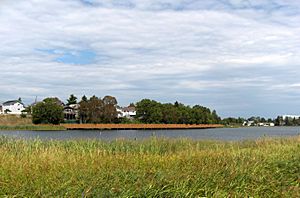
Timmins has many fun places to visit:
- The Timmins Museum and National Exhibition Centre is a great place to learn about the city's history.
- Cedar Meadows Wilderness Tours offers chances to see wildlife.
- Mount Jamieson Resort (formerly Kamiskotia Snow Resort) is a place for skiing and snowboarding.
- Porcupine Ski Runners Cross-Country Trails and Chalet is perfect for cross-country skiing.
- There are also several golf clubs: Hollinger Golf Club, Spruce Needles Golf Club, and Sandy Falls Golf Club.
- The McIntyre Community Building is a popular spot for sports and events.
- Snowmobiling is very popular, with tourists coming from all over North America to ride the trails.
Hollinger Park is a main outdoor space. It has a public park area and fields for baseball and soccer. The baseball park has been home to the Timmins Men's Baseball League since 1985. Famous musician Shania Twain, who grew up in Timmins, played a concert there in 1999. About 22,000 people came to watch.
The Pioneer Museum is about 39.5 kilometers northeast of the city center in Connaught. It shares local history that goes back over 300 years.
The Porcupine Miner's Memorial is a special tribute. It has a statue of a miner and tablets with the names of 594 miners who died in accidents. Later, statues of a mother and two children were added to remember the families they left behind.
The Timmins Public Library was built in 2005 using local wood. Its eco-friendly design was recognized for using resources well and being sustainable.
Sports in Timmins
The Timmins Rock is the city's junior A hockey team. They play in the Northern Ontario Junior Hockey League. Their younger team, the Timmins Majors, is the Midget AAA team. Both teams play at the McIntyre Community Building.
Media in Timmins
In 1952, J. Conrad Lavigne started CFCL, the first French-language radio station in Ontario.
The Timmins Daily Press is the main English newspaper, published six times a week. There are also French newspapers like Le Voyageur and Le Journal L'Express de Timmins.
Learning in Timmins
Colleges and Universities
Timmins has two main colleges:
- Northern College is a College of Applied Arts and Technology.
- Collège Boréal is a French-language college. It also has a campus of Université de Hearst.
- Algoma University offers degrees in Social Work and Community Development at the Northern College Campus.
School Boards
Four different school boards serve the City of Timmins:
- District School Board Ontario North East
- Northeastern Catholic District School Board
- Conseil scolaire catholique de district des Grandes-Rivières (Catholic French-language)
- Conseil scolaire public du Nord-Est de l'Ontario (Public French-language)
High Schools
- O'Gorman High School
- École Publique Renaissance
- École secondaire catholique Thériault
- Timmins High and Vocational School
- Roland Michener Secondary School
Healthcare in Timmins
The Timmins and District Hospital (TADH) is a hospital that serves Timmins and nearby areas. It is a teaching hospital, meaning it helps train new medical professionals. Patients needing more advanced care from the Weeneebayko Area Health Authority are also sent here.
The hospital has 134 beds. It was formed in 1988 by combining two older hospitals. The current hospital building was built in 1996.
Getting Around Timmins
The Timmins Victor M. Power Airport is the main airport for the area. For ground travel, Ontario Northland Motor Coach Services provides bus service from the Timmins Transit Terminal.
The closest train stations are more than 100 kilometers away. These include Foleyet and Gogama, which are served by The Canadian, a cross-Canada passenger train. To the north, Cochrane is where the Polar Bear Express train starts. Within Timmins, Timmins Transit provides local bus service.
Famous People from Timmins
- Alfred Aho: A computer scientist who won the Turing Award.
- Charlie Angus: A musician and a Member of Parliament for Timmins-James Bay.
- Paul Bellini: A comedy writer and actor.
- Natalie Brown: An actress.
- Anthony Del Col: A writer who won a Pulitzer Prize.
- Derek Edwards: A comedian.
- Maurice LaMarche: A comedian and voice actor.
- Lights (Valerie Poxleitner): A singer-songwriter.
- Frank Mahovlich: A famous NHL hockey player and Canadian Senator.
- Pete Mahovlich: An NHL hockey player.
- Jim Prentice: A former Premier of Alberta.
- Myron Scholes: An economist who won a Nobel Prize.
- Shania Twain: A world-famous musician.
- Preston Pablo: A musician.
Famous Athletes from Timmins
- Bill Barilko: An NHL hockey player, famous for a song by The Tragically Hip.
- Sharon Bruneau: A female bodybuilder and actress.
- Les Costello: An NHL hockey player who later became a priest.
- Shean Donovan: An NHL hockey player.
- Kathy Kreiner: A gold medalist in alpine skiing at the Olympics.
- Frank Mahovlich: An NHL hockey player and Canadian Senator.
- Pete Mahovlich: An NHL hockey player.
- Gus Mortson: An NHL hockey player.
- Bob Nevin: An NHL hockey player.
- Dave Poulin: An NHL hockey player.
- Dean Prentice: An NHL hockey player.
- Steve Sullivan: An NHL hockey player.
- Walt Tkaczuk: An NHL hockey player.
- Eric Vail: An NHL hockey player who won the Calder Trophy.
See also
 In Spanish: Timmins para niños
In Spanish: Timmins para niños




